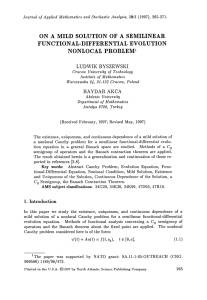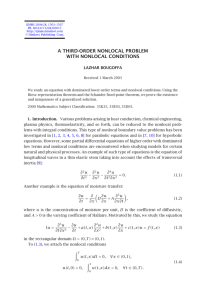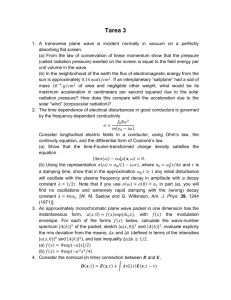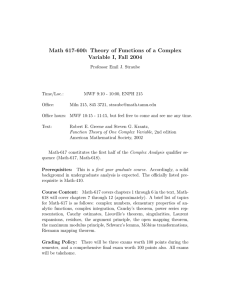UNIQUENESS AND A EXISTENCE
advertisement
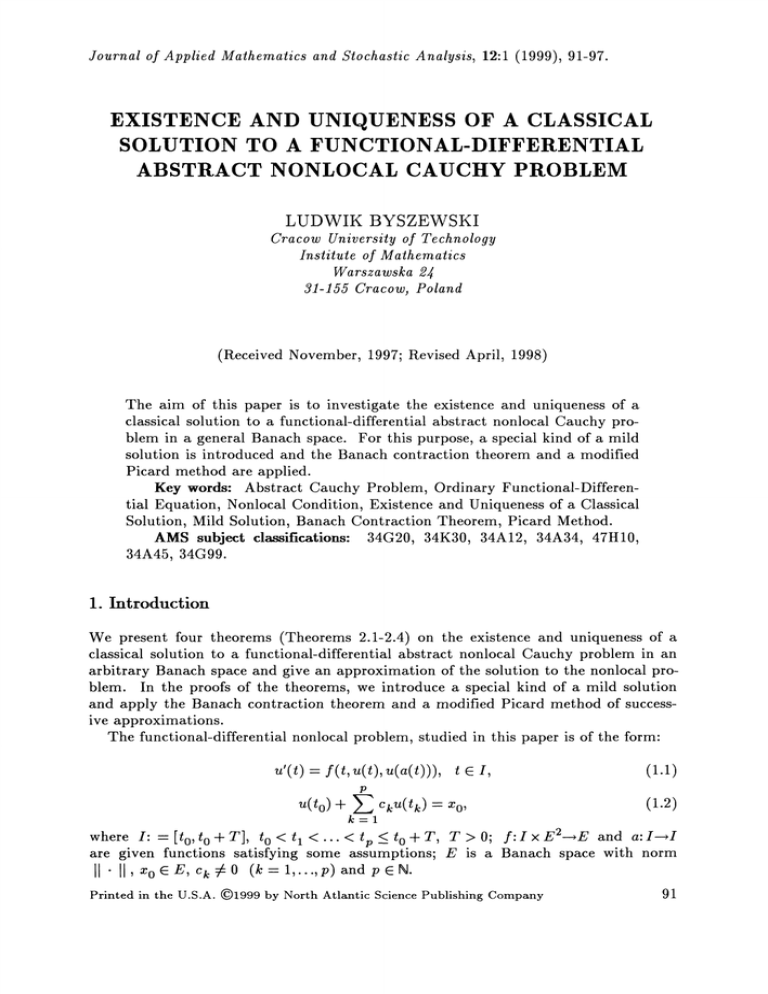
Journal
of Applied Mathematics
and Stochastic Analysis, 12:1
(1999), 91-97.
EXISTENCE AND UNIQUENESS OF A CLASSICAL
SOLUTION TO A FUNCTIONAL-DIFFERENTIAL
ABSTRACT NONLOCAL CAUCHY PROBLEM
LUDWIK BYSZEWSKI
Cracow University of Technology
Institute
of Mathematics
Warszawska 2
31-155 Cracow, Poland
(Received November, 1997; Revised April, 1998)
The aim of this paper is to investigate the existence and uniqueness of a
classical solution to a functional-differential abstract nonlocal Cauchy problem in a general Banach space. For this purpose, a special kind of a mild
solution is introduced and the Banach contraction theorem and a modified
Picard method are applied.
Key words: Abstract Cauchy Problem, Ordinary Functional-Differential Equation, Nonlocal Condition, Existence and Uniqueness of a Classical
Solution, Mild Solution, Banach Contraction Theorem, Picard Method.
AMS subject classifications: 34G20, 34K30, 34A12, 34A34, 47H10,
34A45, 34G99.
1. Introduction
We present four theorems (Theorems 2.1-2.4)
on the existence and uniqueness of a
classical solution to a functional-differential abstract nonlocal Cauchy problem in an
arbitrary Banach space and give an approximation of the solution to the nonlocal problem. In the proofs of the theorems, we introduce a special kind of a mild solution
and apply the Banach contraction theorem and a modified Picard method of success-
ive approximations.
The functional-differential nonlocal problem, studied in this paper is of the form:
u’(t)
f(t,u(t), u(a(t))),
t
I,
(1.1)
p
u(to) +
E cku(tk)
Xo’
(1.2)
k=l
where I: -[to, t o+T], t o<t l<...<tp_<t o+T, T>0; f:IE2--E and a:I--,I
are given functions satisfying some assumptions; E is a Banach space with norm
II, xo G E, c k :/- O (k=l,...,p) andpN.
I
Printed in the U.S.A.
()1999 by North
Atlantic Science Publishing Company
91
LUDWIK BYSZEWSKI
92
The results obtained are generalizations and continuations of those, reported previously in [1-4], with the nonlocal condition of type (1.2). Moreover, the results of
the paper include, among other things, a special kind of a mild solution to nonlocal
problem (1.1)-(1.2). Therefore, throughout the proofs of the theorems, we apply properties of function f in a greater measure than in [1-3]. Consequently, in contrast
with [1-3], now, even if T is an arbitrary positive constant, then ck(k- 1,..., p) from
the nonlocal condition (1.2) can satisfy the inequalities ckl > 1 (k- 1,...,p). The
special kind of a mild solution in this paper is a modification of a mild solution introduced by the author (in [5]), for nonlocal evolution problems. In the case when c k
0 (k 1,..., p) and the right-hand side of the functional-differential equation does not
depend on the functional argument, some results of Theorem 2.4 are reduced to those
(given in [6]) on the existence and uniqueness of a classical solution to the abstract
Cauchy problem with the standard initial condition.
If c k =/= 0 (k 1,..., p) then the results of the paper can be applied in kinematics to
determine the evolution tu(t) of the location of a physical object for which we do
not know the positions U(to) u( tl ),
U( t p) but we know that the nonlocal condition
(1.2) holds. Consequently, to describe some physical phenomena, the nonlocal condition can be more useful than the standard initial condition u(t0) x 0.
2. Theorems About the Existence and Uniqueness of a Classical Solution
By X,
we denote the Banach space
I w I x:
C(I,E)
sup
with the standard norm
]1 w(t)II,
wG
I1" I x"
So,
x.
p
Assume that
k=l
u(t)-
ck
x0
#
1. A function u E
E ck
k=l
X, satisfying the integral equation
f(7", u(7), u(a(’)))dr
1
+ E ck
(2.1)
k=l
tO
f(7", u(r), u(a(v))dr, t I,
is said to be a mild solution of the nonlocal problem (1.1)-(1.2).
A function u" IE is said to be a classical solution of the nonlocal problem
(1.2) if
u is continuous on I and continuously differentiable on I,
(i)
(ii) u’(t)- f(t, u(t), u(a(t))) for t e I
and
p
(iii)
(to) +
E
k=l
Theorem 2.1"
classical solution
problem.
Suppose that
f:IxE2E,
(1.1)-
P
a:I---,I and
of the nonlocal problem (1.1)-(1.2),
If
u is a
then u is a mild solution
of this
k=l
c k 7 -1.
Abstract Nonlocal Cauchy Problem
93
Proof: Let u be a classical solution of the nonlocal problem
satisfies equation (1.1) and, consequently,
u(to) -t-
u(t)
/ f(’, u(7), u(a(7)))d’,
(1.1)-(1.2).
Then u
(2.2)
t @ I.
o
From (2.2),
k
u(to) +
u(tk)
/
f(r, u(7), u(a(v)))dr (k
1,..., p).
(2.3)
o
By (1.2)and (2.3),
u(to) +
E ck
U(to) +
k=l
f(r,u(-),u(a(r)))dv
x o.
to
P
Since
E
k--1
--1, then (2.4)implies
ck
u(to)- :Co-
E ck
k=l
f(r, u(r), u(a(v’)))dr
1
+
E ck
k=l
to
From (2.2) and (2.5), we obtain that u is a mild solution of the nonlocal problem
(1.1)-(1.2). The proof of Theorem 2.1 is complete,
p
Theorem 2.2: Suppose that f E C(IE2, E), a:I--I and
c k7 -1. Ifu is a
k=l
mild solution
of the nonlocal problem (1.1)-(1.2) then
u is a classical solution
of this
problem.
Proof: Let u be a mild solution of the nonlocal problem (1.1)-(1.2). Then u
satisfies equation (1.1) and, from the continuity of f,u CI(I,E). Now, we will
show that u satisfies the nonlocal condition (1.2). For this purpose, observe that, by
(2.1),
u(to)- Xo-
E ck
k=l
and
u(ti)- XO-
f(v, u(7), u(a(r)))dv
/
S(v, u(’), u(a(’)))d
1
o
some computations,
+
E ck
k=l
to
f(r,u(v),u(a(r)))d7
From (2.6) and (2.7), and from
E ck
k=l
t"
+
+
to
E ck
k=l
1
(i
1,...,p).
LUDWIK BYSZEWSKI
94
u(to) -4-
lCiU(ti)
E Ck
x0
k=l
+ E ci
i=1
f(r, u(v), u(a(r)))dr
to
f(-, u(r), u(a(’)))dr
x o.
to
Therefore, the proof of Theorem 2.2 is complete.
As a consequence of Theorems 2.1 and 2.2, we obtain:
Theorem 2.3: Suppose that f E C(I E 2, E), a: I--,I and
p
k=l
#
ck
-1. Then u is
the unique classical solution of the nonlocal problem (1.1)-(1.2) if and only if u is the
unique mild solution of this problem.
Now, we will prove the main theorem of the paper.
Theorem 2.4: Assume that:
a C(I,I), f:I E2--E is continuous with respect to the first variable on
(i)
I and there is L > 0 such that
2
I f(8,Zl,Z2)- f(8,1,2)II
<_ L
E I zi-’i I
(2.8)
i-- 1
for s I, zi,
,
E (i-1,2),
P
(ii)
and
k
1
ck
#
1
2LT(1A_I ( Ck)/(
1.
1A-
k=l
k=l
Then the nonlocal Cauchy problem (1.1)-(1.2) has a unique classical solution u.
successive approximations u n (n- O, 1, 2,...), defined by the formulas
Moreover, the
u0(t):
xo
for t I
(2.9)
and
u n + l(t)"
x0
+
f(v, Un(’), un(a(r)))dr
ck
k=l
1
+
ci,
k=l
to
(2.10)
/ f(7-, un(r), un(a(v)) for
t
I (n
O, 1,2,...),
o
converge uniformly on I to the unique classical solution u.
Proof: Introduce an operator A by the formula
(Aw)(t):
xo
E Ck
k=l
f(r, w(r), w(a(r)))d"
to
1
+
E Ck
k=l
(2.11)
Abstract Nonlocal Cauchy Problem
+
/ f(v, w(r), w(a(’)))dT,
wE
95
I.
X, t
o
It is easy to see that
A" X--X.
Now,
we will show that
A is a contraction
on
(2.12)
X. For this purpose observe that
(Aw)(t)-(A)(t)
=
/
E ck
k=l
+
/ If(v,
k
P
(a(r)))]dr
+ E ck
1
k=l
to
f If(v,
//( (2i13)
P
w(r), w(a(r)))- f(r, (7),
w(r), w(a(’))) f(v, (r),
(a(v)))]dT,
e X,
w,
t
e I.
o
From (2.13)and (2.8),
I (Aw)(t)- (A )(t) I
<_2LT 1+
(2.14)
Eck I w- fix, w, CX,
1+
ck
k=l
tCI.
k=l
Let
+1 ( Ck)/(
:,
) I).
1--
k=l
k=l
(2.15)
Then, by (2.14), (2.15)and assumption (iii),
[[ Aw A I x <- q I
with 0
<q<
I x for w,
EX
(2.16)
1.
Consequently, by (2.12) and (2.16), operator A satisfies all the assumptions of the
Banach contraction theorem. Therefore, in space X there is only one fixed point u of
A and this point is the mild solution of the nonlocal problem (1.1)-(1.2). Consequently, from Theorem 2.3, u is the unique classical solution of the nonlocal problem (1.1)-
(1.2).
Now,
we will prove the second part of the thesis of Theorem 2.4.
observe that by
To this end,
(2.10)and (2.9),
I Ul
Ec
k=l
U0 I X
sup
tI
I ul(t)- u0(t)[[
f(r, Uo(r), uo(a(r)))d7
tO
1
(2.17)
+
Ec
k=l
LUDWIK BYSZEWSKI
96
If(v, u0(7), uo(a(7)))d7
sup
+ tI
o
<MT
(l_t_](ck)/(l_t_
k=l
where
sup{ I f(7, w(7), w(a(7)))II’w
M:
Next,
assume that
(2.18)
k=l
k=l
n-1
for some natural n > 2.
Then, by (2.10), (2.9),
(2.8)and (2.18),
I u. + 1 un I x
I
sup
ti
.
+ 1(t) un(t) I
(2.19)
Eck [f(7,tn(7),tn(a(7)))- f(7,tn-l(7),ztn-l(a(7)))]d7
k=l
1+
to
[f(7, Un(7), un(a(7))
sup
+ tel
<_ 2LT
1
+
1
ck
k=l
1+
ck
1
-+-
1
E Ck
1
(a(7)))]d7
I Ztn- Ztn-1 I x
ck
2LT 1
+
k=l
-
(7), u n
k
k=l
+
k=l
f(7, u n
Ec
k=l
ck
1
+
ck
k=l
k=l
Therefore, from (2.17), (2.18), (2.19), and from mathematical induction,
I .-.-1 I x
/1
MT 1 +
c
k=l
1
+
(2.20)
k=l
n-1
1-tk=l
Abstract Nonlocal Cauchy Problem
for all n 1, 2,
Inequalities (2.20) and assumption
uniform convergence of the series
ttl+
on the interval
(iii) imply, by the
97
Weierstrass theorem, the
E(Un+l
I and, consequently, the uniform convergence of the sequence u n on I.
Let
u,(t)" =nlimun(t) for t e I.
Since u n tends uniformly to u, on I then, by (2.9), (2.10) and (2.8), u, is a classical
solution of the nonlocal problem (1.1)-(1.2) on I. But, from the first part of the
thesis of Theorem 2.4, we know that there exists only one classical solution u of the
nonlocal problem (1.1)-(1.2) on I. So, u, u on I.
The proof of Theorem 2.4 is complete.
Peferences
[1]
[2]
[4]
Byszewski, L. and Lakshmikantham, V., Theorem about the existence and
uniqueness of a solution of a nonlocal abstract Cauchy problem in a Banach
space, Appl. Anal. 40 (1990), 11-19.
Byszewski, L., Existence of approximate solution to abstract nonlocal Cauchy
problem, J. of Appl. Math. and Stoch. Anal. 5.4 (1992), 363-374.
Byszewski, L., Differential and Functional-Differential Problems with Nonlocal
Conditions, Cracow University of Technology, Monograph 184, Cracow 1995.
Byszewski, L., On weak solutions of functional-differential abstract nonlocal
Cauchy problem, Annales Polonici Math. 65 (1997), 163-170.
Byszewski, L., Application of properties of the right-hand sides of evolution
equations to an investigation of nonlocal evolution problems, Nonl. Anal."
Theory, Methods and Appl. (1998), in press.
Lakshmikantham, V. and Leela, S., Nonlinear Differential Equations in
Abstract Spaces, Pergamon Press, Oxford, New York, Toronto, Sydney, Paris,
Frankfurt 1981.


